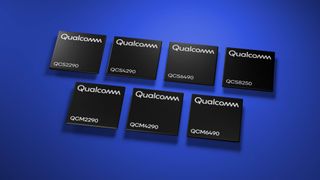Qualcomm unveils 7 new IoT chipsets to power next-gen devices
Meant for a host of functionalities

Global chip major Qualcomm has unveiled seven new IoT chipsets targeted at devices meant for transportation and logistics, warehousing, video collaboration, smart cameras, retail and healthcare, among others.
The company said the seven new IoT solutions "offer a breadth of capabilities for a range of smart devices and connected solutions with extended life hardware and software options for achieving long-term support for a minimum of eight years."
The new chipsets are: Qualcomm QCS8250, Qualcomm QCS6490/ QCM6490, Qualcomm QCS4290/ QCM4290, and the Qualcomm QCS2290/ QCM2290.
Recently, Qualcomm launched its first IoT modem solution that is equipped with 5G connectivity and optimised for Industrial IoT (IIoT) applications.
- Chennai startups are winners in Qualcomm’s hardware challenge
- Jio, Qualcomm kickoff 5G trials, clock over 1 Gbps speed
These chipsets come in two variants
The chipsets are entry level to premium tier, and purpose-built to support emerging IoT devices and solutions designed for industrial and commercial applications.
There are two variants, one classified under the QCS family, which is an application processor with WiFi connectivity. The other is slotted under the QCM, which is an application processor with an integrated cellular connectivity.
Qualcomm QCS8250
Get daily insight, inspiration and deals in your inbox
Get the hottest deals available in your inbox plus news, reviews, opinion, analysis and more from the TechRadar team.
Target applications: connected healthcare, digital signage, retail, and video collaboration.
This premium-tier offering is optimised to deliver maximum performance to enable compute intensive AI at the edge with support for Qualcomm Wi-Fi 6 solutions and 5G connectivity. It offers a new Neural Processing Unit (NPU) for ultra-intuitive AI in addition to machine learning for compute-intensive IoT applications to enable smart cameras, video collaboration, AI hubs, connected healthcare and smart retail.
Qualcomm QCS6490/QCM6490
Target applications: connected healthcare, logistics management, retail, transportation, and warehousing.
With the Kryo 585 CPU architecture this solution is purpose-built for industrial and commercial IoT applications such as transportation, warehousing, connected healthcare, logistics management and across retail point of sale (POS) kiosks.
Equipped to support 5G mmWave/Sub-6 GHz and Wi-Fi 6E, this solution helps enable the latest generation of handhelds and tablets, industrial scanners, and human machine interface systems.
Qualcomm QCS4290/QCM4290
Target applications: cameras, industrial handhelds, and security panels.
These chipsets offer maximum mid-tier benefits. With the Kryo260 CPU architecture for increased speeds and robust on-device performance, in addition to the 3rd generation Qualcomm AI Engine, this platform delivers powerful performance, dynamic camera capabilities and broad connectivity options (LTE Cat13, Wi-Fi 6-Ready).
Qualcomm QCS2290/QCM2290
Target applications: camera applications, industrial handhelds, retail and tracking.
These are robust entry-level offerings, enabling reliable performance and power-conservation with LTE connectivity, upgraded features and memory support for low power consumption. Equipped with the Cortex A53 CPU architecture, the entry-level platform is a cost-effective solution, delivering greater performance, higher graphics capabilities, better quality images, and improved power performance. This platform is well-suited for, retail point-of-sale (POS),industrial handheld, tracking and camera applications.
New chipsets' availability
The Qualcomm QCS8250, Qualcomm QCS4290/ QCM4290, and Qualcomm QCS2290/ QCM2290 solutions are available now. The Qualcomm QCS6490/ QCM6490 solution are expected to be available in second half of 2021.
The company said its partners including Amtran, Arrow, Honeywell, Quectel and Lantronix are already trialling the IoT chipsets, employing them to develop modules and commercial products.

Over three decades as a journalist covering current affairs, politics, sports and now technology. Former Editor of News Today, writer of humour columns across publications and a hardcore cricket and cinema enthusiast. He writes about technology trends and suggest movies and shows to watch on OTT platforms.
Most Popular


